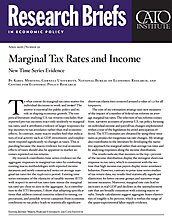My research contributes time series evidence on the aggregate responses to marginal tax rates by combining existing macro methodologies with reported income measures and newly constructed series on average marginal tax rates for the 1946–2012 period. Existing time series estimates of the elasticity of taxable income (ETI) with respect to net-of-tax rates (one minus the marginal tax rate) are close to zero in the aggregate. As a contribution to the ETI literature, I show that adopting specifications that address central concerns related to timing, expectations, and possible reverse causation from economic conditions to tax policy leads to statistically significant short-run elasticities centered around a value of 1.2 for all taxpayers.
The core of my estimation strategy uses new measures of the impact of a number of federal tax reforms on average marginal tax rates. The selection of tax reforms comes from narrative accounts of postwar U.S. tax policy, focusing on individual income and payroll tax changes implemented within a year of the legislation (to avoid anticipation effects). The ETI estimates are obtained by using these measures as proxies for exogenous tax rate changes. My strategy also contributes to the literature by developing the narrative approach for marginal rather than average tax rates and by analyzing responses along the income distribution.
The results indicate that incomes in the top 1 percent of the income distribution display the strongest short-run response to tax rates, which is consistent with the notion that high income-tax payers display more avoidance behavior. However, contrary to prior time series studies of tax return data, my results find statistically significant elasticities for lower income groups and narrower wage income measures. Moreover, marginal rate cuts lead to increases in real GDP and declines in the unemployment rate that are broadly consistent with existing macro results. Simple calculations suggest aggregate hours elasticities of roughly 0.80 percent, which is within the range of the quasi-experimental labor supply evidence.
My study also conducts a novel test to determine whether real economic activity responds primarily to marginal or average tax rates. Combining measures of tax changes, I estimate the consequences of counterfactual tax experiments leading to changes in marginal tax rates but not in average tax rates, and vice versa. Marginal rate changes lead to similar income responses regardless of the change in the average tax rate. But no evidence suggests any effect on incomes when average tax rates decline but marginal rates do not. Thus U.S. federal tax policy seems to operate through incentive effects rather than disposable income and demand stimulus.
Finally, my study analyzes the impact of a counterfactual tax reform that cuts marginal tax rates only for the top 1 percent of the income distribution. The estimated short run taxable income elasticity for the top 1 percent is around 1.5, and a cut in the top marginal rate raises real GDP, lowers aggregate unemployment, and has a measurable positive effect on incomes outside the top 1 percent. Nevertheless, marginal rate cuts targeting top incomes lead to greater income inequality. These results have implications for the observed correlation between top marginal rates and top income shares; causal explanations based on avoidance or rent-seeking alone cannot explain the finding that top marginal rate cuts have real economic effects and spill over to lower income groups. Using the methodology in my work, the nature of the postwar variation in marginal tax rates unfortunately does not permit any conclusions about the impact of tax reforms that change tax rates for lower income groups only.
Thus based on a narrative strategy to obtain measures of exogenous variation in marginal tax rates, this study finds significant and broad based effects on reported income. This is consistent with recent macro studies detecting substantial effects of tax changes on real economic variables in the United States and other countries using similar identification approaches. However, it conflicts with existing evidence in the public finance literature that uses aggregate time series constructed from tax returns. The difference can be explained by the efforts to address possible reverse causation from the business cycle to tax policy. One may certainly question whether these efforts truly circumvent all reverse causation problems. At the least, however, this paper demonstrates the importance of taking steps to mitigate the influence of confounding factors.
As in any time series study, it is necessary to assume that the economic environment at some level is stable across the sample. It is therefore risky to draw strong conclusions about the impact of particular historical or contemplated future tax reforms. With these caveats in mind, my findings are relevant for assessing the role of income taxation for macroeconomic stabilization and austerity programs, for understanding the empirical relationship between income taxes and inequality, and for optimal tax policy. Although disagreement about magnitudes remains, the results also add indirectly to the growing evidence that hours and employment decisions are influenced by taxes.
Future research can usefully verify and extend the analysis in several ways. The identification of exogenous variation in marginal tax rates discussed here relies on a limited number of postwar tax reforms in the United States; but tax return data and narrative datasets are becoming increasingly available for other countries, which allows for replication of the results. Second, measuring the long-run effects of marginal tax rate changes in U.S. data alone is extremely challenging. However, separating the effects of temporary and permanent tax changes at least for top incomes may be feasible by incorporating prewar data.
Note
This research brief is based on Karel Mertens, “Marginal Tax Rates and Income: New Time Series Evidence,” National Bureau of Economic Research Working Paper no. 19171, http://www.nber.org/papers/w19171, September 2015.
